Jianfeng Dong
Towards Efficient General Feature Prediction in Masked Skeleton Modeling
Sep 03, 2025Abstract:Recent advances in the masked autoencoder (MAE) paradigm have significantly propelled self-supervised skeleton-based action recognition. However, most existing approaches limit reconstruction targets to raw joint coordinates or their simple variants, resulting in computational redundancy and limited semantic representation. To address this, we propose a novel General Feature Prediction framework (GFP) for efficient mask skeleton modeling. Our key innovation is replacing conventional low-level reconstruction with high-level feature prediction that spans from local motion patterns to global semantic representations. Specifically, we introduce a collaborative learning framework where a lightweight target generation network dynamically produces diversified supervision signals across spatial-temporal hierarchies, avoiding reliance on pre-computed offline features. The framework incorporates constrained optimization to ensure feature diversity while preventing model collapse. Experiments on NTU RGB+D 60, NTU RGB+D 120 and PKU-MMD demonstrate the benefits of our approach: Computational efficiency (with 6.2$\times$ faster training than standard masked skeleton modeling methods) and superior representation quality, achieving state-of-the-art performance in various downstream tasks.
UW-3DGS: Underwater 3D Reconstruction with Physics-Aware Gaussian Splatting
Aug 08, 2025Abstract:Underwater 3D scene reconstruction faces severe challenges from light absorption, scattering, and turbidity, which degrade geometry and color fidelity in traditional methods like Neural Radiance Fields (NeRF). While NeRF extensions such as SeaThru-NeRF incorporate physics-based models, their MLP reliance limits efficiency and spatial resolution in hazy environments. We introduce UW-3DGS, a novel framework adapting 3D Gaussian Splatting (3DGS) for robust underwater reconstruction. Key innovations include: (1) a plug-and-play learnable underwater image formation module using voxel-based regression for spatially varying attenuation and backscatter; and (2) a Physics-Aware Uncertainty Pruning (PAUP) branch that adaptively removes noisy floating Gaussians via uncertainty scoring, ensuring artifact-free geometry. The pipeline operates in training and rendering stages. During training, noisy Gaussians are optimized end-to-end with underwater parameters, guided by PAUP pruning and scattering modeling. In rendering, refined Gaussians produce clean Unattenuated Radiance Images (URIs) free from media effects, while learned physics enable realistic Underwater Images (UWIs) with accurate light transport. Experiments on SeaThru-NeRF and UWBundle datasets show superior performance, achieving PSNR of 27.604, SSIM of 0.868, and LPIPS of 0.104 on SeaThru-NeRF, with ~65% reduction in floating artifacts.
Rethinking Visual Layer Selection in Multimodal LLMs
Apr 30, 2025Abstract:Multimodal large language models (MLLMs) have achieved impressive performance across a wide range of tasks, typically using CLIP-ViT as their visual encoder due to its strong text-image alignment capabilities. While prior studies suggest that different CLIP-ViT layers capture different types of information, with shallower layers focusing on fine visual details and deeper layers aligning more closely with textual semantics, most MLLMs still select visual features based on empirical heuristics rather than systematic analysis. In this work, we propose a Layer-wise Representation Similarity approach to group CLIP-ViT layers with similar behaviors into {shallow, middle, and deep} categories and assess their impact on MLLM performance. Building on this foundation, we revisit the visual layer selection problem in MLLMs at scale, training LLaVA-style models ranging from 1.4B to 7B parameters. Through extensive experiments across 10 datasets and 4 tasks, we find that: (1) deep layers are essential for OCR tasks; (2) shallow and middle layers substantially outperform deep layers on reasoning tasks involving counting, positioning, and object localization; (3) a lightweight fusion of features across shallow, middle, and deep layers consistently outperforms specialized fusion baselines and single-layer selections, achieving gains on 9 out of 10 datasets. Our work offers the first principled study of visual layer selection in MLLMs, laying the groundwork for deeper investigations into visual representation learning for MLLMs.
Fine-Grained Controllable Apparel Showcase Image Generation via Garment-Centric Outpainting
Mar 03, 2025Abstract:In this paper, we propose a novel garment-centric outpainting (GCO) framework based on the latent diffusion model (LDM) for fine-grained controllable apparel showcase image generation. The proposed framework aims at customizing a fashion model wearing a given garment via text prompts and facial images. Different from existing methods, our framework takes a garment image segmented from a dressed mannequin or a person as the input, eliminating the need for learning cloth deformation and ensuring faithful preservation of garment details. The proposed framework consists of two stages. In the first stage, we introduce a garment-adaptive pose prediction model that generates diverse poses given the garment. Then, in the next stage, we generate apparel showcase images, conditioned on the garment and the predicted poses, along with specified text prompts and facial images. Notably, a multi-scale appearance customization module (MS-ACM) is designed to allow both overall and fine-grained text-based control over the generated model's appearance. Moreover, we leverage a lightweight feature fusion operation without introducing any extra encoders or modules to integrate multiple conditions, which is more efficient. Extensive experiments validate the superior performance of our framework compared to state-of-the-art methods.
Multi-Pair Temporal Sentence Grounding via Multi-Thread Knowledge Transfer Network
Dec 20, 2024



Abstract:Given some video-query pairs with untrimmed videos and sentence queries, temporal sentence grounding (TSG) aims to locate query-relevant segments in these videos. Although previous respectable TSG methods have achieved remarkable success, they train each video-query pair separately and ignore the relationship between different pairs. We observe that the similar video/query content not only helps the TSG model better understand and generalize the cross-modal representation but also assists the model in locating some complex video-query pairs. Previous methods follow a single-thread framework that cannot co-train different pairs and usually spends much time re-obtaining redundant knowledge, limiting their real-world applications. To this end, in this paper, we pose a brand-new setting: Multi-Pair TSG, which aims to co-train these pairs. In particular, we propose a novel video-query co-training approach, Multi-Thread Knowledge Transfer Network, to locate a variety of video-query pairs effectively and efficiently. Firstly, we mine the spatial and temporal semantics across different queries to cooperate with each other. To learn intra- and inter-modal representations simultaneously, we design a cross-modal contrast module to explore the semantic consistency by a self-supervised strategy. To fully align visual and textual representations between different pairs, we design a prototype alignment strategy to 1) match object prototypes and phrase prototypes for spatial alignment, and 2) align activity prototypes and sentence prototypes for temporal alignment. Finally, we develop an adaptive negative selection module to adaptively generate a threshold for cross-modal matching. Extensive experiments show the effectiveness and efficiency of our proposed method.
Dynamic Adapter with Semantics Disentangling for Cross-lingual Cross-modal Retrieval
Dec 18, 2024



Abstract:Existing cross-modal retrieval methods typically rely on large-scale vision-language pair data. This makes it challenging to efficiently develop a cross-modal retrieval model for under-resourced languages of interest. Therefore, Cross-lingual Cross-modal Retrieval (CCR), which aims to align vision and the low-resource language (the target language) without using any human-labeled target-language data, has gained increasing attention. As a general parameter-efficient way, a common solution is to utilize adapter modules to transfer the vision-language alignment ability of Vision-Language Pretraining (VLP) models from a source language to a target language. However, these adapters are usually static once learned, making it difficult to adapt to target-language captions with varied expressions. To alleviate it, we propose Dynamic Adapter with Semantics Disentangling (DASD), whose parameters are dynamically generated conditioned on the characteristics of the input captions. Considering that the semantics and expression styles of the input caption largely influence how to encode it, we propose a semantic disentangling module to extract the semantic-related and semantic-agnostic features from the input, ensuring that generated adapters are well-suited to the characteristics of input caption. Extensive experiments on two image-text datasets and one video-text dataset demonstrate the effectiveness of our model for cross-lingual cross-modal retrieval, as well as its good compatibility with various VLP models.
Rethinking Video Deblurring with Wavelet-Aware Dynamic Transformer and Diffusion Model
Aug 24, 2024Abstract:Current video deblurring methods have limitations in recovering high-frequency information since the regression losses are conservative with high-frequency details. Since Diffusion Models (DMs) have strong capabilities in generating high-frequency details, we consider introducing DMs into the video deblurring task. However, we found that directly applying DMs to the video deblurring task has the following problems: (1) DMs require many iteration steps to generate videos from Gaussian noise, which consumes many computational resources. (2) DMs are easily misled by the blurry artifacts in the video, resulting in irrational content and distortion of the deblurred video. To address the above issues, we propose a novel video deblurring framework VD-Diff that integrates the diffusion model into the Wavelet-Aware Dynamic Transformer (WADT). Specifically, we perform the diffusion model in a highly compact latent space to generate prior features containing high-frequency information that conforms to the ground truth distribution. We design the WADT to preserve and recover the low-frequency information in the video while utilizing the high-frequency information generated by the diffusion model. Extensive experiments show that our proposed VD-Diff outperforms SOTA methods on GoPro, DVD, BSD, and Real-World Video datasets.
Alleviating Hallucination in Large Vision-Language Models with Active Retrieval Augmentation
Aug 01, 2024
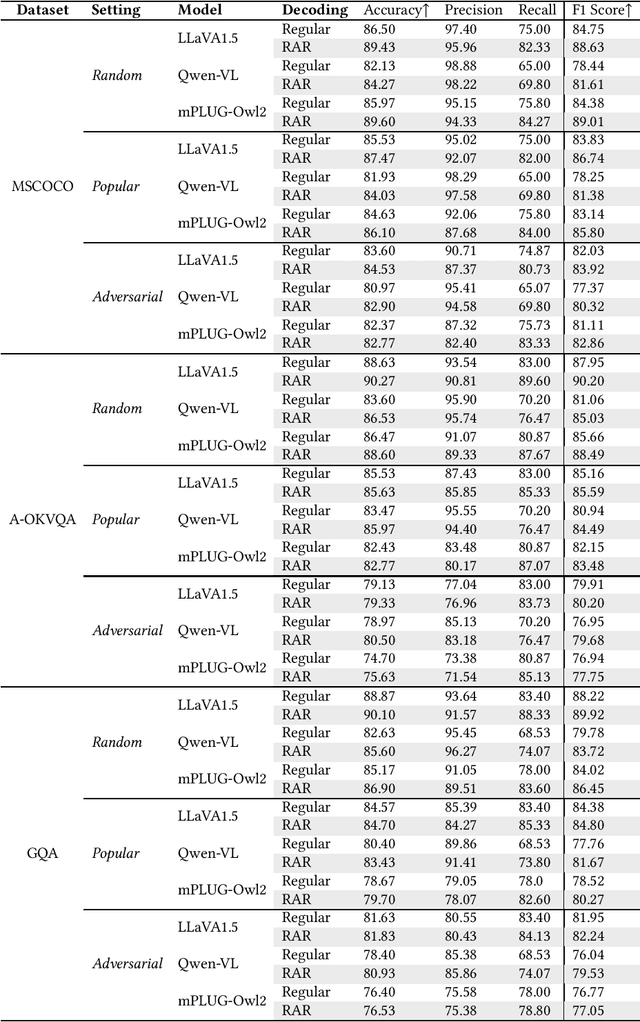
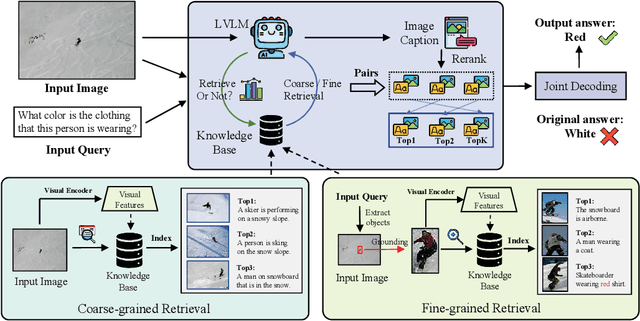
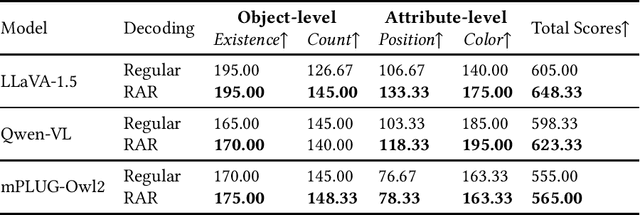
Abstract:Despite the remarkable ability of large vision-language models (LVLMs) in image comprehension, these models frequently generate plausible yet factually incorrect responses, a phenomenon known as hallucination.Recently, in large language models (LLMs), augmenting LLMs by retrieving information from external knowledge resources has been proven as a promising solution to mitigate hallucinations.However, the retrieval augmentation in LVLM significantly lags behind the widespread applications of LVLM. Moreover, when transferred to augmenting LVLMs, sometimes the hallucination degree of the model is even exacerbated.Motivated by the research gap and counter-intuitive phenomenon, we introduce a novel framework, the Active Retrieval-Augmented large vision-language model (ARA), specifically designed to address hallucinations by incorporating three critical dimensions: (i) dissecting the retrieval targets based on the inherent hierarchical structures of images. (ii) pinpointing the most effective retrieval methods and filtering out the reliable retrieval results. (iii) timing the retrieval process to coincide with episodes of low certainty, while circumventing unnecessary retrieval during periods of high certainty. To assess the capability of our proposed ARA model in reducing hallucination, we employ three widely used LVLM models (LLaVA-1.5, Qwen-VL, and mPLUG-Owl2) across four benchmarks. Our empirical observations suggest that by utilizing fitting retrieval mechanisms and timing the retrieval judiciously, we can effectively mitigate the hallucination problem. We hope that this study can provide deeper insights into how to adapt the retrieval augmentation to LVLMs for reducing hallucinations with more effective retrieval and minimal retrieval occurrences.
Mitigating Multilingual Hallucination in Large Vision-Language Models
Aug 01, 2024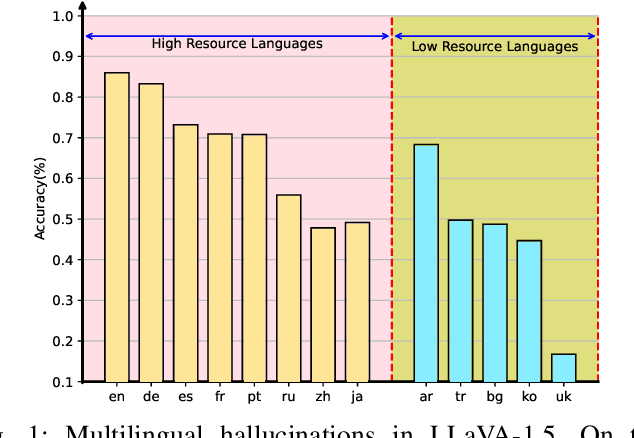
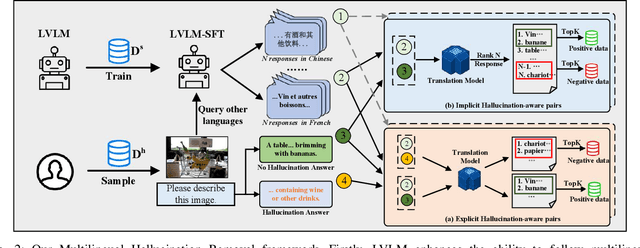
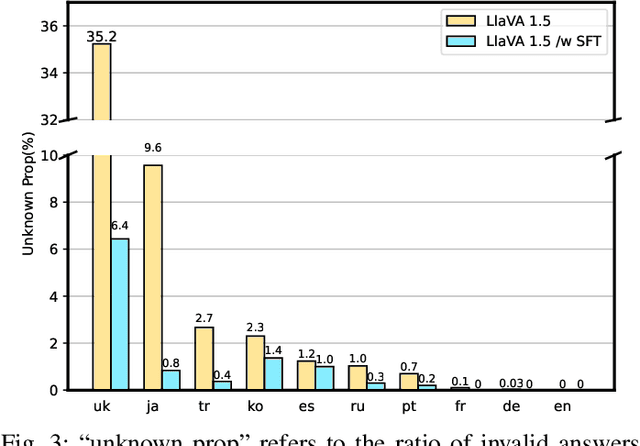

Abstract:While Large Vision-Language Models (LVLMs) have exhibited remarkable capabilities across a wide range of tasks, they suffer from hallucination problems, where models generate plausible yet incorrect answers given the input image-query pair. This hallucination phenomenon is even more severe when querying the image in non-English languages, while existing methods for mitigating hallucinations in LVLMs only consider the English scenarios. In this paper, we make the first attempt to mitigate this important multilingual hallucination in LVLMs. With thorough experiment analysis, we found that multilingual hallucination in LVLMs is a systemic problem that could arise from deficiencies in multilingual capabilities or inadequate multimodal abilities. To this end, we propose a two-stage Multilingual Hallucination Removal (MHR) framework for LVLMs, aiming to improve resistance to hallucination for both high-resource and low-resource languages. Instead of relying on the intricate manual annotations of multilingual resources, we fully leverage the inherent capabilities of the LVLM and propose a novel cross-lingual alignment method, which generates multiple responses for each image-query input and then identifies the hallucination-aware pairs for each language. These data pairs are finally used for direct preference optimization to prompt the LVLMs to favor non-hallucinating responses. Experimental results show that our MHR achieves a substantial reduction in hallucination generation for LVLMs. Notably, on our extended multilingual POPE benchmark, our framework delivers an average increase of 19.0% in accuracy across 13 different languages. Our code and model weights are available at https://github.com/ssmisya/MHR
Representation Alignment Contrastive Regularization for Multi-Object Tracking
Apr 03, 2024Abstract:Achieving high-performance in multi-object tracking algorithms heavily relies on modeling spatio-temporal relationships during the data association stage. Mainstream approaches encompass rule-based and deep learning-based methods for spatio-temporal relationship modeling. While the former relies on physical motion laws, offering wider applicability but yielding suboptimal results for complex object movements, the latter, though achieving high-performance, lacks interpretability and involves complex module designs. This work aims to simplify deep learning-based spatio-temporal relationship models and introduce interpretability into features for data association. Specifically, a lightweight single-layer transformer encoder is utilized to model spatio-temporal relationships. To make features more interpretative, two contrastive regularization losses based on representation alignment are proposed, derived from spatio-temporal consistency rules. By applying weighted summation to affinity matrices, the aligned features can seamlessly integrate into the data association stage of the original tracking workflow. Experimental results showcase that our model enhances the majority of existing tracking networks' performance without excessive complexity, with minimal increase in training overhead and nearly negligible computational and storage costs.
 Add to Chrome
Add to Chrome Add to Firefox
Add to Firefox Add to Edge
Add to Edge